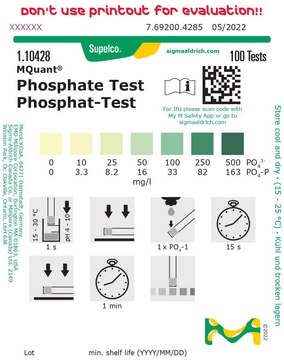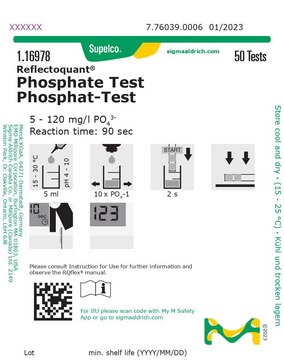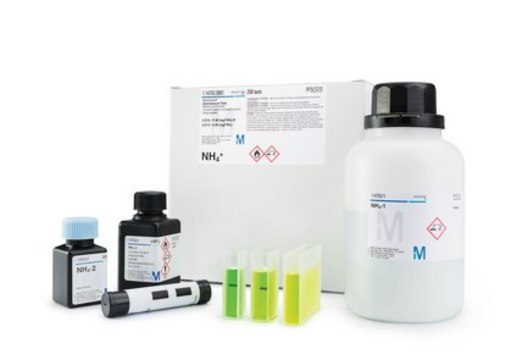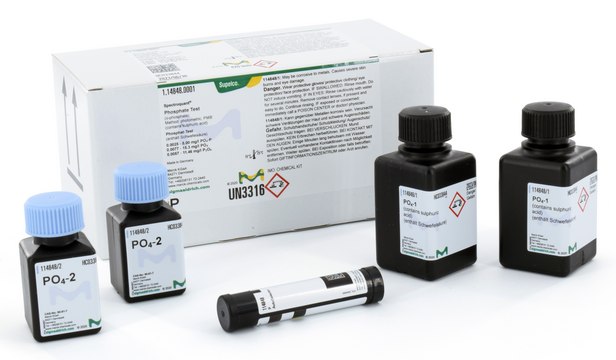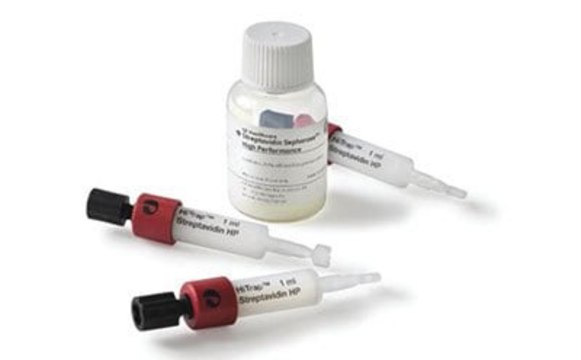MAK030
Phosphate Colorimetric Kit
sufficient for 500 colorimetric tests
Sign Into View Organizational & Contract Pricing
All Photos(2)
About This Item
UNSPSC Code:
12161503
NACRES:
NA.84
Recommended Products
usage
sufficient for 500 colorimetric tests
application(s)
cosmetics
environmental
food and beverages
detection method
colorimetric
storage temp.
room temp
General description
Phosphate is an essential component in living organisms and contributes to a variety of biological functions, including structural roles within nucleic acids, cellular membranes, and bone. Phosphate is also important in the transport of cellular energy, nucleic acid metabolism, and signal transduction. Hyperphosphatemia, a condition of excess phosphate levels in the blood, can lead to calcification of organs and interference with usage of other inorganic ions, such as iron, calcium, magnesium, and zinc.
The Phosphate Colorimetric Assay Kit provides a simple and direct procedure for measuring phosphate in a variety of samples. Phosphate reacts with a chromogenic complex, which results in a colorimetric (650 nm) product proportional to the amount of phosphate present. Phosphate concentrations between 1 μM and 1 mM, with a lower limit of detection of 0.1 nmol, can be directly determined.
The Phosphate Colorimetric Assay Kit provides a simple and direct procedure for measuring phosphate in a variety of samples. Phosphate reacts with a chromogenic complex, which results in a colorimetric (650 nm) product proportional to the amount of phosphate present. Phosphate concentrations between 1 μM and 1 mM, with a lower limit of detection of 0.1 nmol, can be directly determined.
Application
Phosphate colorimetric kit has been used to measure the phosphate concentration in a variety of samples.
Suitability
Suitable for measuring phosphate levels in a variety of samples including serum and urine
Principle
The Phosphate Colorimetric Assay Kit provides a simple and direct procedure for measuring phosphate in a variety of samples. Phosphate reacts with a chromogenic complex, which results in a colorimetric (650 nm) product proportional to the amount of phosphate present. Phosphate concentrations between 1 μM and 1 mM, with a lower limit of detection of 0.1 nmol, can be directly determined.
replaced by
Product No.
Description
Pricing
Signal Word
Warning
Hazard Statements
Precautionary Statements
Hazard Classifications
Aquatic Chronic 3 - Eye Irrit. 2 - Met. Corr. 1 - Skin Irrit. 2
Storage Class Code
8A - Combustible corrosive hazardous materials
Choose from one of the most recent versions:
Certificates of Analysis (COA)
Lot/Batch Number
Don't see the Right Version?
If you require a particular version, you can look up a specific certificate by the Lot or Batch number.
Already Own This Product?
Find documentation for the products that you have recently purchased in the Document Library.
Ronald F S Lee et al.
Scientific reports, 7(1), 1590-1590 (2017-05-10)
The emerging technique termed functional identification of target by expression proteomics (FITExP) has been shown to identify the key protein targets of anti-cancer drugs. Here, we use this approach to elucidate the proteins involved in the mechanism of action of
Pooja Bhardwaj et al.
Antimicrobial agents and chemotherapy, 62(1) (2017-10-19)
Vancomycin-resistant Enterococcus faecium strains (VREfm) are critical public health concerns because they are among the leading causes of hospital-acquired bloodstream infections. Chlorhexidine (CHX) is a bisbiguanide cationic antiseptic that is routinely used for patient bathing and other infection control practices.
Katrin Pontius et al.
New biotechnology, 56, 54-62 (2019-11-27)
Real-time monitoring of bioprocesses plays a key-role in modern industries, providing new information on full-scale production, thus enabling control of the process and allowing it to run at optimal conditions while minimizing waste. Monitoring of phosphates and ammonium in fermentation
Siping Xiong et al.
Oxidative medicine and cellular longevity, 2019, 4616034-4616034 (2019-10-23)
Activation of the renin-angiotensin system (RAS) contributes to the pathogenesis of cardiovascular diseases. Sodium potassium ATPase (NKA) expression and activity are often regulated by angiotensin II (Ang II). This study is aimed at investigating whether DR-Ab, an antibody against 4th
Hai-Jian Sun et al.
Redox biology, 32, 101493-101493 (2020-03-18)
Nitroxyl (HNO), one-electron reduced and protonated sibling of nitric oxide (NO), is a potential regulator of cardiovascular functions. It produces positive inotropic, lusitropic, myocardial anti-hypertrophic and vasodilator properties. Despite of these favorable actions, the significance and the possible mechanisms of
Our team of scientists has experience in all areas of research including Life Science, Material Science, Chemical Synthesis, Chromatography, Analytical and many others.
Contact Technical Service
